Immigrants from Panama vs Tlingit-Haida Community Comparison
COMPARE
Immigrants from Panama
Tlingit-Haida
Social Comparison
Social Comparison
Immigrants from Panama
Tlingit-Haida
1,936
SOCIAL INDEX
16.9/ 100
SOCIAL RATING
282nd/ 347
SOCIAL RANK
5,201
SOCIAL INDEX
49.5/ 100
SOCIAL RATING
182nd/ 347
SOCIAL RANK
Tlingit-Haida Integration in Immigrants from Panama Communities
The statistical analysis conducted on geographies consisting of 41,583,243 people shows a weak positive correlation between the proportion of Tlingit-Haida within Immigrant from Panama communities in the United States with a correlation coefficient (R) of 0.250. On average, for every 1% (one percent) increase in Immigrants from Panama within a typical geography, there is an increase of 0.025% in Tlingit-Haida. To illustrate, in a geography comprising of 100,000 individuals, a rise of 1,000 Immigrants from Panama corresponds to an increase of 24.5 Tlingit-Haida.
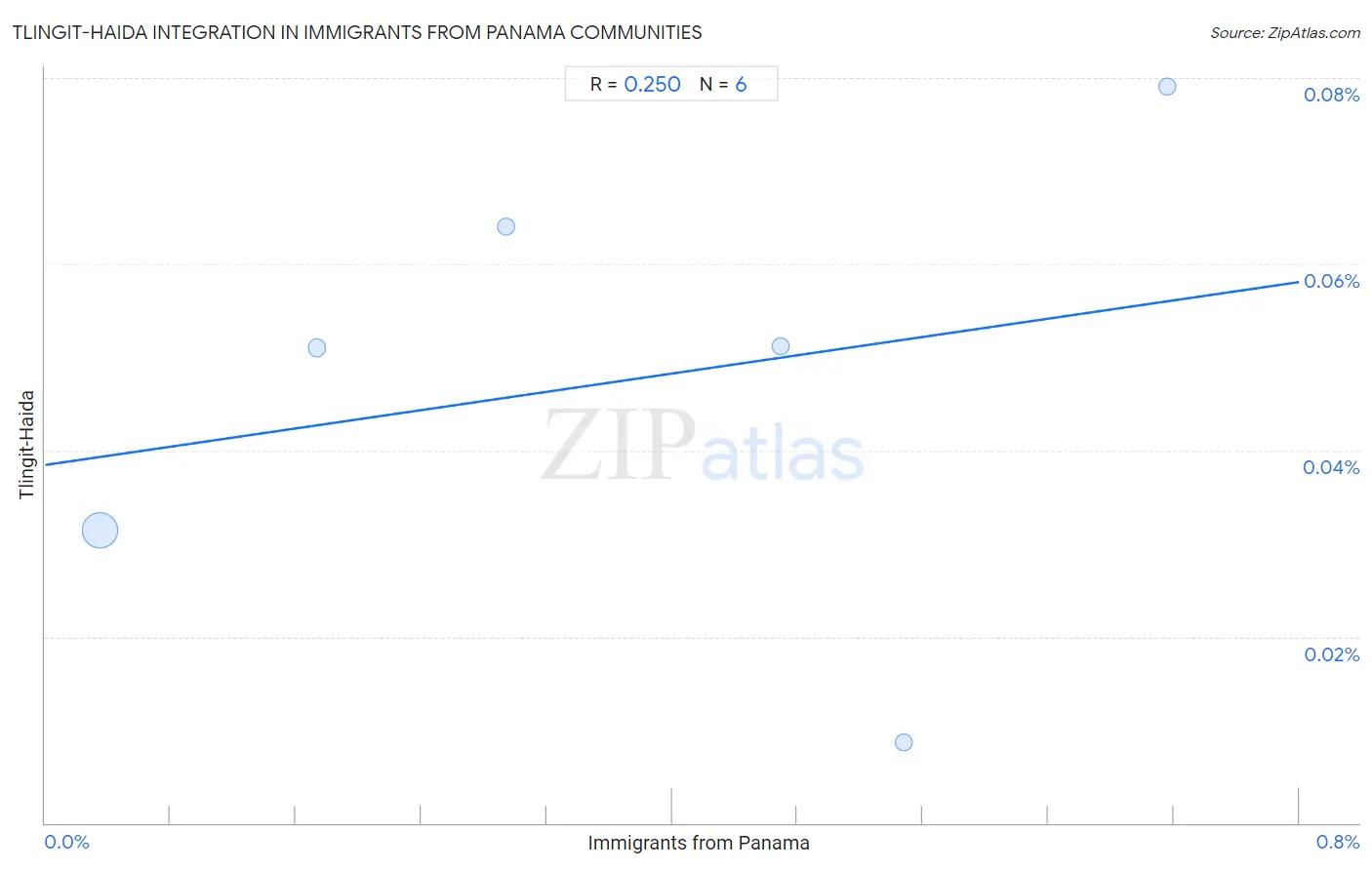
Immigrants from Panama vs Tlingit-Haida Income
When considering income, the most significant differences between Immigrants from Panama and Tlingit-Haida communities in the United States are seen in householder income over 65 years ($56,944 compared to $62,922, a difference of 10.5%), householder income under 25 years ($51,278 compared to $55,914, a difference of 9.0%), and median family income ($95,647 compared to $101,092, a difference of 5.7%). Conversely, both communities are more comparable in terms of median earnings ($45,198 compared to $45,468, a difference of 0.60%), median male earnings ($51,962 compared to $52,409, a difference of 0.86%), and median female earnings ($39,049 compared to $39,513, a difference of 1.2%).

| Income Metric | Immigrants from Panama | Tlingit-Haida |
| Per Capita Income | Poor $41,853 | Average $43,516 |
| Median Family Income | Tragic $95,647 | Fair $101,092 |
| Median Household Income | Tragic $80,873 | Fair $83,968 |
| Median Earnings | Poor $45,198 | Fair $45,468 |
| Median Male Earnings | Tragic $51,962 | Poor $52,409 |
| Median Female Earnings | Fair $39,049 | Average $39,513 |
| Householder Age | Under 25 years | Tragic $51,278 | Exceptional $55,914 |
| Householder Age | 25 - 44 years | Tragic $89,451 | Fair $92,987 |
| Householder Age | 45 - 64 years | Tragic $93,815 | Poor $97,417 |
| Householder Age | Over 65 years | Tragic $56,944 | Excellent $62,922 |
| Wage/Income Gap | Exceptional 23.4% | Exceptional 24.0% |
Immigrants from Panama vs Tlingit-Haida Poverty
When considering poverty, the most significant differences between Immigrants from Panama and Tlingit-Haida communities in the United States are seen in seniors poverty over the age of 65 (12.4% compared to 8.3%, a difference of 48.7%), seniors poverty over the age of 75 (13.9% compared to 9.7%, a difference of 43.6%), and married-couple family poverty (5.8% compared to 4.4%, a difference of 32.0%). Conversely, both communities are more comparable in terms of single female poverty (21.6% compared to 21.9%, a difference of 1.7%), female poverty among 25-34 year olds (14.1% compared to 13.8%, a difference of 2.2%), and single father poverty (15.9% compared to 15.3%, a difference of 3.4%).
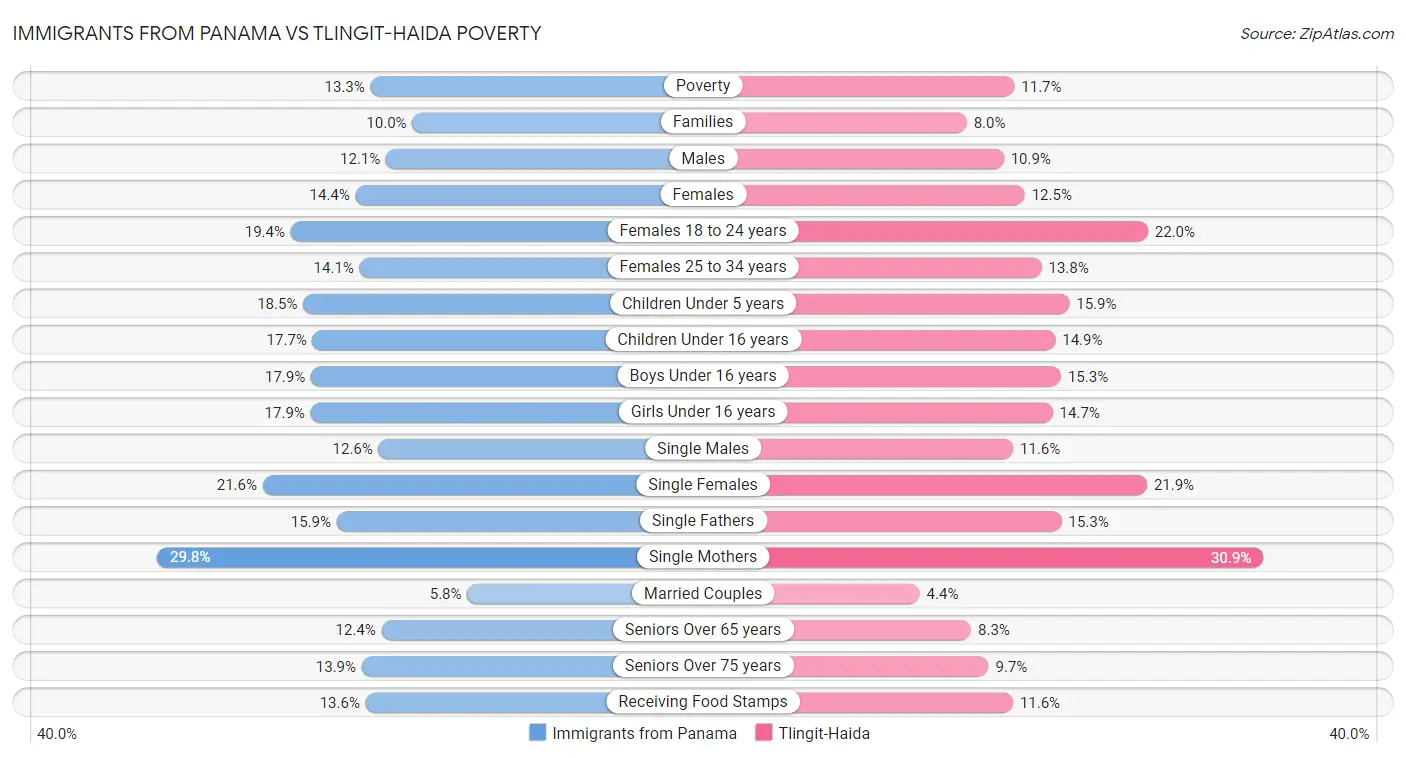
| Poverty Metric | Immigrants from Panama | Tlingit-Haida |
| Poverty | Tragic 13.3% | Excellent 11.7% |
| Families | Tragic 10.0% | Exceptional 8.0% |
| Males | Tragic 12.1% | Good 10.9% |
| Females | Tragic 14.4% | Exceptional 12.5% |
| Females 18 to 24 years | Exceptional 19.4% | Tragic 22.0% |
| Females 25 to 34 years | Poor 14.1% | Fair 13.8% |
| Children Under 5 years | Tragic 18.5% | Exceptional 15.9% |
| Children Under 16 years | Tragic 17.7% | Exceptional 14.9% |
| Boys Under 16 years | Tragic 17.9% | Exceptional 15.3% |
| Girls Under 16 years | Tragic 17.9% | Exceptional 14.7% |
| Single Males | Good 12.6% | Exceptional 11.6% |
| Single Females | Poor 21.6% | Tragic 21.9% |
| Single Fathers | Exceptional 15.9% | Exceptional 15.3% |
| Single Mothers | Poor 29.8% | Tragic 30.9% |
| Married Couples | Tragic 5.8% | Exceptional 4.4% |
| Seniors Over 65 years | Tragic 12.4% | Exceptional 8.3% |
| Seniors Over 75 years | Tragic 13.9% | Exceptional 9.7% |
| Receiving Food Stamps | Tragic 13.6% | Average 11.6% |
Immigrants from Panama vs Tlingit-Haida Unemployment
When considering unemployment, the most significant differences between Immigrants from Panama and Tlingit-Haida communities in the United States are seen in unemployment among seniors over 75 years (8.2% compared to 20.7%, a difference of 153.2%), unemployment among seniors over 65 years (5.1% compared to 6.8%, a difference of 33.6%), and unemployment among ages 60 to 64 years (4.8% compared to 6.4%, a difference of 32.1%). Conversely, both communities are more comparable in terms of unemployment (5.5% compared to 5.6%, a difference of 0.74%), unemployment among ages 45 to 54 years (4.6% compared to 4.7%, a difference of 1.8%), and unemployment among youth under 25 years (12.4% compared to 12.7%, a difference of 1.8%).
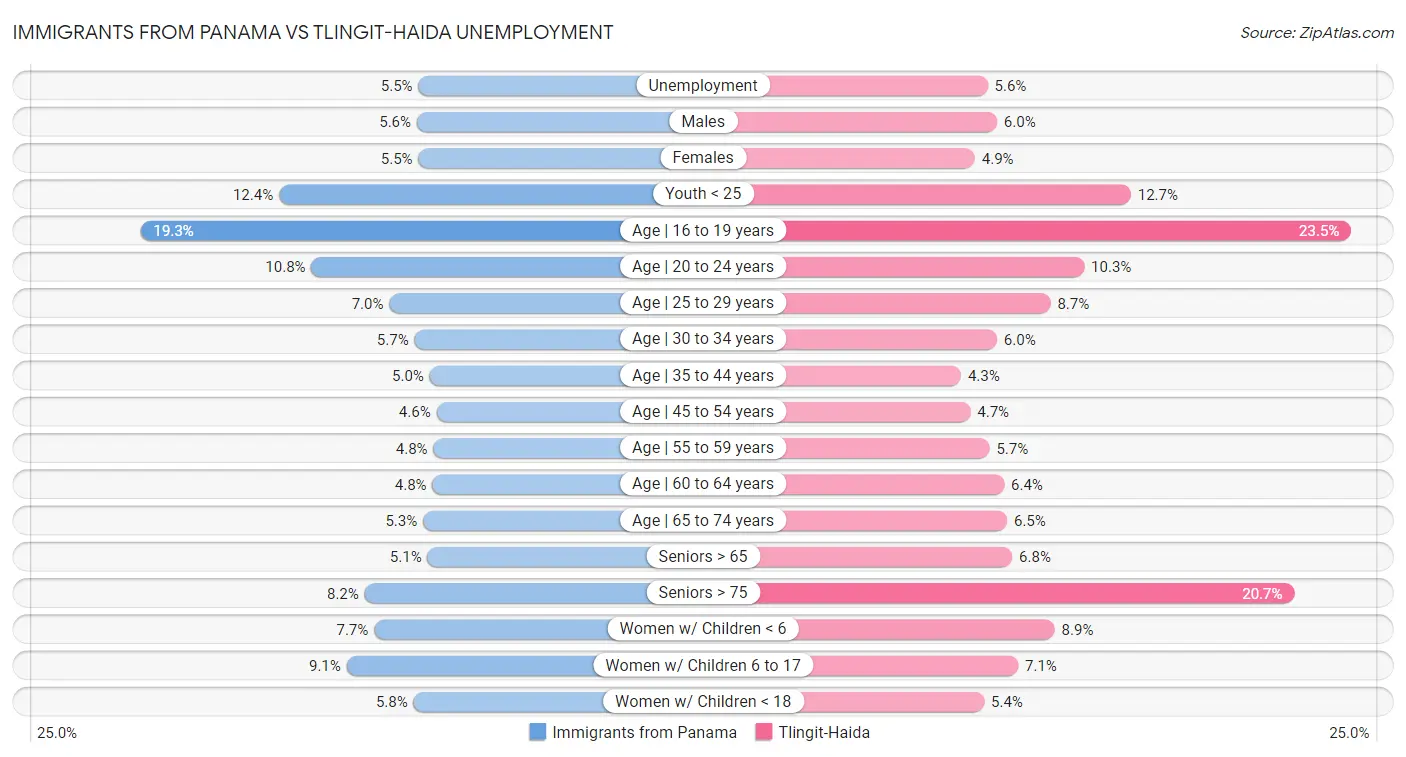
| Unemployment Metric | Immigrants from Panama | Tlingit-Haida |
| Unemployment | Tragic 5.5% | Tragic 5.6% |
| Males | Tragic 5.6% | Tragic 6.0% |
| Females | Tragic 5.5% | Exceptional 4.9% |
| Youth < 25 | Tragic 12.4% | Tragic 12.7% |
| Age | 16 to 19 years | Tragic 19.3% | Tragic 23.5% |
| Age | 20 to 24 years | Tragic 10.8% | Fair 10.3% |
| Age | 25 to 29 years | Tragic 7.0% | Tragic 8.7% |
| Age | 30 to 34 years | Tragic 5.7% | Tragic 6.0% |
| Age | 35 to 44 years | Tragic 5.0% | Exceptional 4.3% |
| Age | 45 to 54 years | Poor 4.6% | Tragic 4.7% |
| Age | 55 to 59 years | Good 4.8% | Tragic 5.7% |
| Age | 60 to 64 years | Good 4.8% | Tragic 6.4% |
| Age | 65 to 74 years | Excellent 5.3% | Tragic 6.5% |
| Seniors > 65 | Excellent 5.1% | Tragic 6.8% |
| Seniors > 75 | Exceptional 8.2% | Tragic 20.7% |
| Women w/ Children < 6 | Fair 7.7% | Tragic 8.9% |
| Women w/ Children 6 to 17 | Fair 9.1% | Exceptional 7.1% |
| Women w/ Children < 18 | Tragic 5.8% | Good 5.4% |
Immigrants from Panama vs Tlingit-Haida Labor Participation
When considering labor participation, the most significant differences between Immigrants from Panama and Tlingit-Haida communities in the United States are seen in in labor force | age 16-19 (34.0% compared to 40.5%, a difference of 19.1%), in labor force | age 20-24 (73.9% compared to 77.9%, a difference of 5.4%), and in labor force | age 30-34 (84.3% compared to 82.3%, a difference of 2.4%). Conversely, both communities are more comparable in terms of in labor force | age 20-64 (79.1% compared to 79.0%, a difference of 0.16%), in labor force | age 25-29 (84.2% compared to 84.4%, a difference of 0.26%), and in labor force | age > 16 (65.1% compared to 65.5%, a difference of 0.65%).

| Labor Participation Metric | Immigrants from Panama | Tlingit-Haida |
| In Labor Force | Age > 16 | Average 65.1% | Excellent 65.5% |
| In Labor Force | Age 20-64 | Tragic 79.1% | Tragic 79.0% |
| In Labor Force | Age 16-19 | Tragic 34.0% | Exceptional 40.5% |
| In Labor Force | Age 20-24 | Tragic 73.9% | Exceptional 77.9% |
| In Labor Force | Age 25-29 | Tragic 84.2% | Poor 84.4% |
| In Labor Force | Age 30-34 | Tragic 84.3% | Tragic 82.3% |
| In Labor Force | Age 35-44 | Tragic 84.0% | Tragic 82.5% |
| In Labor Force | Age 45-54 | Tragic 82.2% | Exceptional 83.9% |
Immigrants from Panama vs Tlingit-Haida Family Structure
When considering family structure, the most significant differences between Immigrants from Panama and Tlingit-Haida communities in the United States are seen in single mother households (7.2% compared to 5.7%, a difference of 24.7%), single father households (2.4% compared to 2.7%, a difference of 13.7%), and family households with children (27.7% compared to 26.0%, a difference of 6.5%). Conversely, both communities are more comparable in terms of married-couple households (44.6% compared to 45.1%, a difference of 1.3%), average family size (3.27 compared to 3.16, a difference of 3.7%), and currently married (44.9% compared to 46.7%, a difference of 4.0%).

| Family Structure Metric | Immigrants from Panama | Tlingit-Haida |
| Family Households | Exceptional 64.8% | Tragic 61.6% |
| Family Households with Children | Excellent 27.7% | Tragic 26.0% |
| Married-couple Households | Tragic 44.6% | Tragic 45.1% |
| Average Family Size | Exceptional 3.27 | Tragic 3.16 |
| Single Father Households | Average 2.4% | Tragic 2.7% |
| Single Mother Households | Tragic 7.2% | Exceptional 5.7% |
| Currently Married | Tragic 44.9% | Average 46.7% |
| Divorced or Separated | Tragic 12.6% | Tragic 13.2% |
| Births to Unmarried Women | Tragic 34.2% | Fair 32.2% |
Immigrants from Panama vs Tlingit-Haida Vehicle Availability
When considering vehicle availability, the most significant differences between Immigrants from Panama and Tlingit-Haida communities in the United States are seen in no vehicles in household (14.6% compared to 10.1%, a difference of 45.5%), 4 or more vehicles in household (5.7% compared to 6.8%, a difference of 20.9%), and 3 or more vehicles in household (17.7% compared to 19.9%, a difference of 12.1%). Conversely, both communities are more comparable in terms of 1 or more vehicles in household (85.4% compared to 90.1%, a difference of 5.4%), 2 or more vehicles in household (51.1% compared to 55.8%, a difference of 9.2%), and 3 or more vehicles in household (17.7% compared to 19.9%, a difference of 12.1%).

| Vehicle Availability Metric | Immigrants from Panama | Tlingit-Haida |
| No Vehicles Available | Tragic 14.6% | Good 10.1% |
| 1+ Vehicles Available | Tragic 85.4% | Good 90.1% |
| 2+ Vehicles Available | Tragic 51.1% | Good 55.8% |
| 3+ Vehicles Available | Tragic 17.7% | Good 19.9% |
| 4+ Vehicles Available | Tragic 5.7% | Exceptional 6.8% |
Immigrants from Panama vs Tlingit-Haida Education Level
When considering education level, the most significant differences between Immigrants from Panama and Tlingit-Haida communities in the United States are seen in no schooling completed (2.3% compared to 1.5%, a difference of 55.3%), master's degree (14.3% compared to 12.8%, a difference of 11.1%), and doctorate degree (1.6% compared to 1.7%, a difference of 7.2%). Conversely, both communities are more comparable in terms of nursery school (97.8% compared to 98.7%, a difference of 0.97%), 1st grade (97.7% compared to 98.7%, a difference of 0.99%), and kindergarten (97.7% compared to 98.7%, a difference of 1.0%).
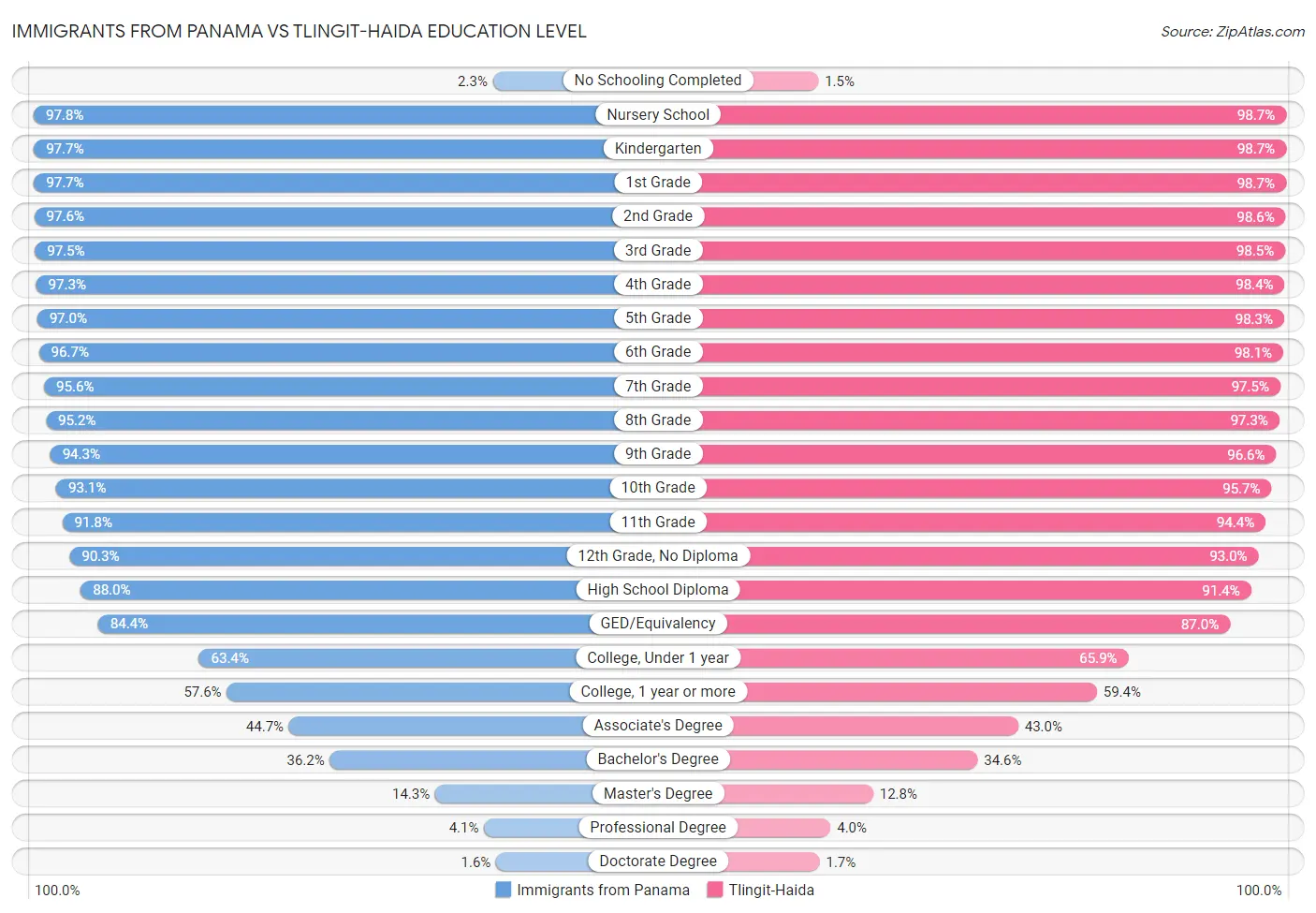
| Education Level Metric | Immigrants from Panama | Tlingit-Haida |
| No Schooling Completed | Tragic 2.3% | Exceptional 1.5% |
| Nursery School | Tragic 97.8% | Exceptional 98.7% |
| Kindergarten | Tragic 97.7% | Exceptional 98.7% |
| 1st Grade | Tragic 97.7% | Exceptional 98.7% |
| 2nd Grade | Tragic 97.6% | Exceptional 98.6% |
| 3rd Grade | Tragic 97.5% | Exceptional 98.5% |
| 4th Grade | Tragic 97.3% | Exceptional 98.4% |
| 5th Grade | Tragic 97.0% | Exceptional 98.3% |
| 6th Grade | Tragic 96.7% | Exceptional 98.1% |
| 7th Grade | Tragic 95.6% | Exceptional 97.5% |
| 8th Grade | Tragic 95.2% | Exceptional 97.3% |
| 9th Grade | Tragic 94.3% | Exceptional 96.6% |
| 10th Grade | Tragic 93.1% | Exceptional 95.7% |
| 11th Grade | Tragic 91.8% | Exceptional 94.4% |
| 12th Grade, No Diploma | Tragic 90.3% | Exceptional 93.0% |
| High School Diploma | Tragic 88.0% | Exceptional 91.4% |
| GED/Equivalency | Tragic 84.4% | Exceptional 87.0% |
| College, Under 1 year | Tragic 63.4% | Good 65.9% |
| College, 1 year or more | Tragic 57.6% | Average 59.4% |
| Associate's Degree | Poor 44.7% | Tragic 43.0% |
| Bachelor's Degree | Poor 36.2% | Tragic 34.6% |
| Master's Degree | Fair 14.3% | Tragic 12.8% |
| Professional Degree | Poor 4.1% | Tragic 4.0% |
| Doctorate Degree | Tragic 1.6% | Poor 1.7% |
Immigrants from Panama vs Tlingit-Haida Disability
When considering disability, the most significant differences between Immigrants from Panama and Tlingit-Haida communities in the United States are seen in hearing disability (2.9% compared to 4.8%, a difference of 66.4%), disability age under 5 (1.2% compared to 1.5%, a difference of 33.3%), and vision disability (2.3% compared to 2.9%, a difference of 22.6%). Conversely, both communities are more comparable in terms of ambulatory disability (6.5% compared to 6.5%, a difference of 0.030%), cognitive disability (17.5% compared to 17.2%, a difference of 1.5%), and disability age 5 to 17 (5.8% compared to 5.9%, a difference of 1.9%).
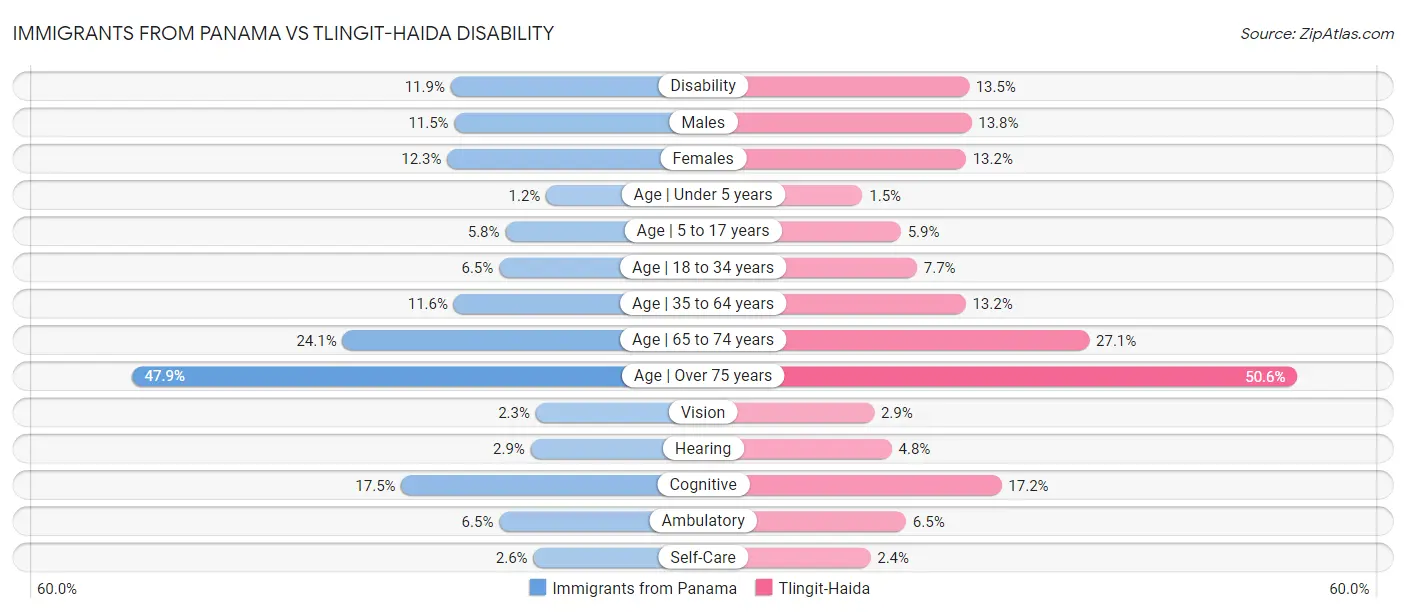
| Disability Metric | Immigrants from Panama | Tlingit-Haida |
| Disability | Poor 11.9% | Tragic 13.5% |
| Males | Poor 11.5% | Tragic 13.8% |
| Females | Fair 12.3% | Tragic 13.2% |
| Age | Under 5 years | Exceptional 1.2% | Tragic 1.5% |
| Age | 5 to 17 years | Tragic 5.8% | Tragic 5.9% |
| Age | 18 to 34 years | Good 6.5% | Tragic 7.7% |
| Age | 35 to 64 years | Fair 11.6% | Tragic 13.2% |
| Age | 65 to 74 years | Tragic 24.1% | Tragic 27.1% |
| Age | Over 75 years | Poor 47.9% | Tragic 50.6% |
| Vision | Tragic 2.3% | Tragic 2.9% |
| Hearing | Good 2.9% | Tragic 4.8% |
| Cognitive | Poor 17.5% | Average 17.2% |
| Ambulatory | Tragic 6.5% | Tragic 6.5% |
| Self-Care | Tragic 2.6% | Good 2.4% |